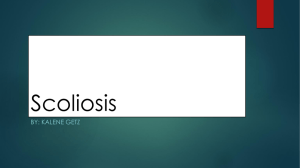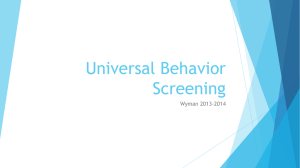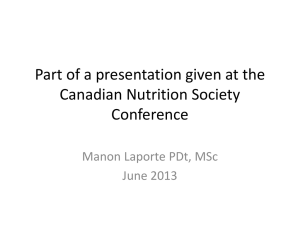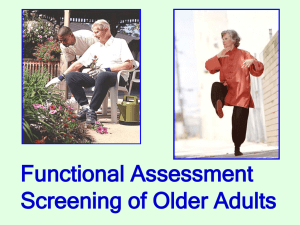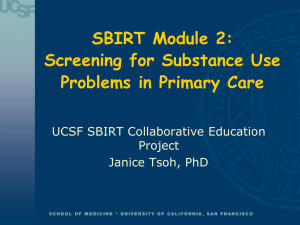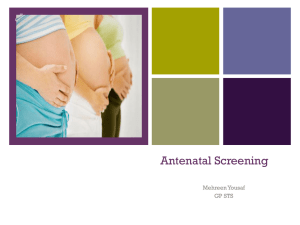Scoliosis Screening Training - Arkansas Coordinated School Health
advertisement
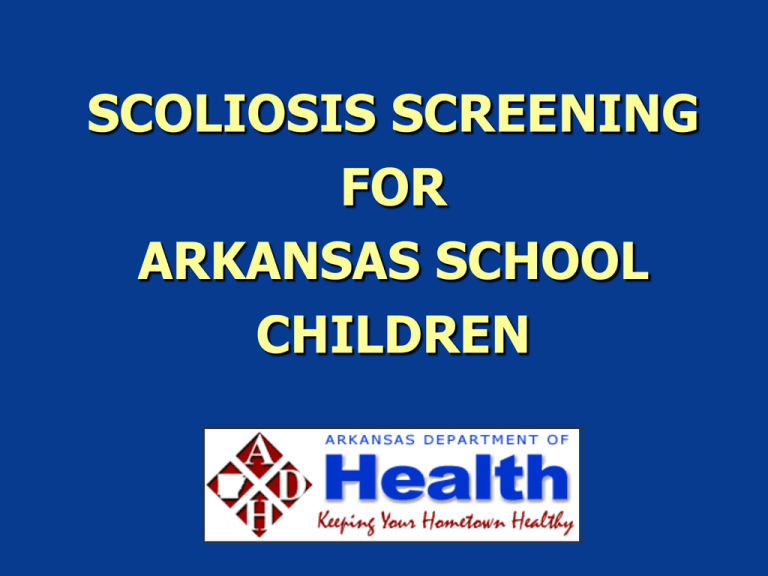
SCOLIOSIS SCREENING FOR ARKANSAS SCHOOL CHILDREN The planning committee & faculty attest that no relevant financial, professional or personal conflict of interest exists, nor was sponsorship of commercial support obtained, in the preparation or presentation of this educational activity. Objectives Participants will be able to: • Explain why scoliosis screening is necessary. • Identify the 9 steps of Scoliosis Screening. • Demonstrate how to perform the first two stages of scoliosis screening. • Differentiate between a normal spine and scoliosis and the recommendation for referral. • Describe the documentation standards for the Scoliosis Program. • Explore diagnostic and treatment options available. • Identify financial and medical resources for referrals. ADH Rules and Regulations For Scoliosis Screening Effective as of November 1, 2007 I. Purpose • Scoliosis is lateral curvature of the spine, resembling an S-curve or a C-curve. • Idiopathic Scoliosis accounts for 85% of all scoliosis cases. • Condition detected in children between ages of 10 and 15 years. • Girls affected more often than boys. • About 2 in 100 people have a mild form of scoliosis. I. Purpose Cont. • Scoliosis can be relatively easily detected by performing a 30 second scoliosis screen. • Early detection and treatment can help prevent physical and emotional disability. • Rules and Regulations provide a method to assure all school age children are screened for scoliosis and necessary referrals for medical follow-up are made. II. Authority: It’s the Law! Arkansas Act 95 of 1989 and Act 41 of 1987 requires that Arkansas Children be screened for scoliosis in selected grades. Rules and regulations implementing the act were adopted by the Arkansas Department of Health and filed in 1998 and revised in November of 2007. III. Definitions • Certified Instructors: Individuals who train the screeners. These shall be licensed health practitioners who have successfully completed the Arkansas Department of Health Instructor Training Course in Scoliosis Screening. III. Continued Definitions • Screeners: Individuals who perform the actual scoliosis screening. These shall be licensed physicians, individuals who have been trained to perform scoliosis screening by a Certified Scoliosis Screening Instructor, or individuals who can document completion of a scoliosis screening workshop within the past five years and demonstrate competence to a Certified Scoliosis Screening Instructor. III. Continued Definitions • Scoliometer: An instrument that measures the degree of rotation of a deformity of the back found on a routine scoliosis screening. III. Continued Definitions • Scoliosis Screening Procedure: The procedure used to examine a child for scoliosis. It consists of evaluating the child in six positions. The forward bend technique is included in three of these positions. III. Continued Definitions • Forward Bend Technique: A technique used to determine the presence or absence of an abnormality of the spine. It involves observing the person being screened from the rear, front, and side while the person is bending forward. III. Continued Definitions • Scoliosis from Greek: skoliōsis meaning from skolios, "crooked" IV. Responsibility: • Who must institute and maintain a continuing scoliosis screening program: • Public elementary and secondary schools • Institutions supported by state funds providing education to minor children • Private institutions providing education to minor children IV. Responsibility: • Rules and Regulations • Arkansas State Board of Health • Training Program • Arkansas Department of Health provides an Instructor Training Course in Scoliosis Screening. V. Screening Program • Qualifications • Licensed physicians • Individuals trained by a Certified Scoliosis Screening Instructor • Individuals providing documentation of successful completion of a Scoliosis Screening Workshop within the past five years and can demonstrate competence to a Certified Scoliosis Instructor. V. Screening Program Cont. • Guidelines for Screening: • Girls- 6th and 8th grades • Boys- 8th grades V. Screening Program Cont. • Screening Procedure (five stages) 1st Stage-Scoliosis Screening Procedure 2nd Stage-Scoliometer 3rd Stage-Recommendation for Referral 4th Stage-Referral System 5th Stage-Follow-Up V. Screening Program Cont. • Recommendation for Referral • Referrals are made on students with an abnormal screening and/or scoliometer reading of > 7°. • It is recommended that scoliometer readings of >8° be referred to an orthopedist. V. Screening Program Cont. • Referral System • Certified Scoliosis Screening Instructor or School Health Nurse shall contact the parents of a child who fails the screening by letter, telephone call, or in person to: 1. explain the findings 2. define and discuss scoliosis 3. discuss the need for referral to a licensed physician • The School shall provide a Scoliosis Screening Report to the parent to take to the licensed physician. V. Screening Program Cont. • Follow-Up • Reschedule absent students for screening within 90 days of missed screening. • Reasons for all exclusions must be documented. • Students referred to a physician for scoliosis screening failure, and then fail to see physician require a second contact by mail, telephone or in person at least one additional time to discuss importance of follow-up VI. Training Program • Certified Scoliosis Screening Instructors must be recertified every five years. VII. Confidentiality of Information VIII. Notification of Screening • At least seven days prior to scoliosis screenings parents must be notified. IX. Exclusions to Screening • Act 41 of 1987 states that "no child shall be screened if its parent or guardian objects to the screening in writing stating as the basis of the objection that it is contrary to the parent's or guardian's religious beliefs.“ X. Quality Assurance The Arkansas Department of Education shall collect statistics on Scoliosis Screening activities in the state. The following information shall be reported annually: 1. the target population eligible for screening 2. the number of children screened 3. the number of children referred 4. the number of children seen by a physician 5. the number of children diagnosed with scoliosis by a physician THE NINE “P’s” Purpose Planning Population Personnel Preparation Place Permission Procedure Paperwork PURPOSE (First “P”) • Early detection to prevent further damage • Detection of other abnormalities o Child Abuse o Acanthosis Nigricans Suspected Child Abuse • Child Abuse as defined by Arkansas code 12-12-503 • Do School Nurses report child abuse? • Reporting the suspected child abuse. • Failure to report suspected abuse. Abuse can be physical or sexual. It includes non-accidental physical injury, shaking a baby, tying a child up, and giving or exposing a child to alcohol or other drugs. Reasonable and moderate discipline (such as spanking) is generally not considered abuse as long as it does not cause injury more serious than transient pain or minor temporary marks and is administered by a parent or guardian. Arkansas code 12-12-503 Reporting Suspected Child Abuse School Nurses are Mandated Reporters Child Abuse Hotline 1.800.482.5964 Failure to Report Suspected Abuse Class C misdemeanor; willful failure to report: civilly liable for all damages proximately caused by that failure. Acanthosis Nigricans/Neck Acanthosis Nigricans/Under Arm Acanthosis Nigricans/Hand PLANNING (Second “P”) • This is the most important “P” • Get organized • Determine date and site then schedule • Recruit help • Notify parents at least 7 days prior • Remind students one day prior to screening • Set up room POPULATION (Third “P”) This changed in November 2007 • Girls are to be screened in the 6th and 8th grades only. • Boys are to be screened in the 8th grade • This includes public and private schools. PERSONNEL (Fourth “P”) • Certified Scoliosis Screener • Physicians • Volunteers PREPARATION (Fifth “P”) • Inform School Staff • Dates, times and locations • Ensure Screeners are either Certified or a Physician • Train volunteers • Inform Students PLACE (Sixth “P”) • Ensure Privacy • Screen boys and girls separately • Good lighting essential PERMISSION (Seventh “P”) • Parental notification at least 7 days prior to screening Act 41 of 1987 states that "no child shall be screened if its parent or guardian objects to the screening in writing stating as the basis of the objection that it is contrary to the parent's or guardian's religious beliefs." PROCEDURE (Eighth “P”) • Screener seated or standing • Student should be 4-6 feet away • Student’s feet two to three inches apart, knees straight and arms hanging loose at side PROCEDURE - Stage 1 Position Position Position Position Position Position 1-Student facing front to screener 2-Student bends forward slowly 3-Student facing to side 4-Student bends forward slowly 5-Student’s back to screener 6-Student bends forward slowly PROCEDURE - Stage 2 • The second phase of screening requires use of the scoliometer. • Student is in position 6 with back to screener bending forward slowly with hands together as if diving. • When using a scoliometer, referral is made on students exhibiting unequal lumbar or thoracic areas of ≥ 7 degrees or greater. NORMAL SPINE Four main areas: Cervical (neck) Thoracic (chest) Lumbar (small of back) Sacral (lower spine) Three Types of Spinal Curves: • Kyphosis-slight curvature is normal. • Lordois-slight curvature is normal. • Scoliosis-lateral curvature is never normal. Scoliosis: • Abnormal lateral curvature of the spine of 10° or more. • Rotation in the spinal column creates a side to side, “S” shaped curve when viewed from behind. STRUCTURAL SCOLIOSIS • Idiopathic – 85% • Congenital • Neuromuscular-CP, MD FUNCTIONAL SCOLIOSIS A structurally normal spine that appears to have a lateral curve (scoliosis). Kyphosis: An abnormal increase in normal kyphotic (posterior) curvature of the thoracic spine which can result in a noticeable round back deformity. Lordosis: Lordosis: An abnormal increase in normal lordotic (anterior) curvature of the lumbar spine. This can lead to a noticeable "swayback“ appearance. EQUIPMENT TREATMENT OPTIONS • Observation Periodic medical examinations and x-rays • Bracing • Surgery PERIODIC EXAMINATIONS • X-RAYS PERIODIC EXAMINATIONS • Risser Sign Skeletal maturity can be assessed by the Risser sign BRACING……then BRACING Milwaukee Brace BRACING BRACING…..now BRACING…..now SURGERY Vertebral Body Stapling (VBS) Application of metal staples to the front of the spine. Staples are inserted between two vertebral bodies, which squeezes the growth plates and slows the growth of that side of the spine. PAPERWORK (Ninth “P”) Make written referrals and follow-up as indicated Complete School Scoliosis Screening Annual Summary in APSCN. Parent Notification of Scoliosis Screening Dear Parent, During the next few weeks a scoliosis screening program will be conducted to screen children for scoliosis in school. Scoliosis is a sideways curving of the spine, resembling an S – curve or C – curve. Eighty-five percent of the time scoliosis has no known cause and tends to run in families. This type of scoliosis first develops between the ages of 10 –15 years and occurs more often in girls than boys. If scoliosis is detected early, treatment can be started and almost all of the curving can be prevented. The procedure for screening is a simple one in which the child’s back is observed as he/she stands upright and as he/she bends forward. To observe this condition, each child will be asked to remove their shirt or blouse (girls may wear bra or bathing suit top with an open back). The screening will be conducted in privacy with only student and examiner present. Any curvature or “back hump” that is noticed during the screening may indicate the need for further studies. If a problem is found, you will be notified. We will recommend that you take your child to a physician of your choice for an evaluation. We encourage all students to participate in this program. If you do not want your child screened please let us know in writing by three days before the screening date. Phone calls will not be accepted. If your child is currently under treatment for a back problem, please let us know in writing. C. Scapula Address: C. Waist D. Waist D. Hips E. Hips Screener: 1 3 5 Grade: Class: Student Name M/F DOB 2 4 6 Confirm Findings Y/N Followup Needs School Follow-up: Yes/No B. Shoulder Diagnosis & treatment Report Date Received: School: Date Referred for Exam: B. Shoulder Date Family Contacted A. Head Rescreening Date: Screener: A. Head Under Current Medical Treatment SPINAL SCREENING WORKSHEET FILLING OUT THE SPINAL SCREENING WORKSHEET It is important that the screener include as much information as possible about His/Her findings for easy reference in the rescreening. The pictures on the spinal screening worksheet represent the positions in which the student is viewed by the Screener. The front, back, and side views each have several areas of focus. Each area has a letter designation. Use these letters on the worksh Adapted from the Texas department of Health, Bureau of Matenal & Child Health , Child Health division, December 1985 Parent Notification - Scoliosis Screening Follow-up Needed Dear Parent, This letter is in regards to the scoliosis screening your child received on at . A trained screener checked your child’s back and has recommended further evaluation by a physician of your choice. We would like to emphasize that this is just a screening. A complete examination by a physician is recommended to determine if there is a problem. We urge you to contact a physician within the next two weeks. The Division of Children’s Medical Services (CMS), Department of Human Services may offer financial assistance for this evaluation when needed. Parents must apply for CMS prior to obtaining the medical evaluation. Contact your School Nurse for more information about this program. Sincerely, School Nurse Dear Doctor: In accordance with Act 41 of 1987 and Act 95 of 1989 our school has conducted an annual scoliosis-screening program for detection of postural deformities such as scoliosis and kyphosis. The purpose of the screening program is to recognize deformities in their earliest stages so that progression can be prevented. Through scoliosis screening, this student has been observed to have variations consistent with either R/L thoracic scoliosis, lumbar scoliosis, or kyphosis. Please review the findings and, if your examination concurs with the screener’s, an appropriate X-ray of the spine should be obtained to establish the diagnosis. It is important that a standard technique be used in getting the X-ray. It is recommended that a single STANDING AP X-ray of the spine be obtained. A 14 x 17-inch film is acceptable if the top of the film is at the level of the shoulders and the tube is centered on the center of the cassette. The child must be standing straight and not be in a slouch position. If a kyphosis has been suspected, than a STANDING lateral film, using the same technique, should be obtained. In order that our school make required reports it is necessary to receive follow-up information from you. Please complete the following information and return this form to the school. Thank you, School Nurse, Scoliosis Screening Program Student Name: X-Ray Shows: DISPOSITION: Signed by Please return to Nurse: M.D. Date: Scoliosis Tracking and Annual Scoliosis Summary Reporting is completed on APSCN. REFERRALS Children’s Services (formerly known as Children’s Medical Services) Department of Human Services Donaghey Plaza South P.O. Box 1437 Slot 526 Little Rock, AR 72203-1437 (Nancy Holder, Program Manager) Toll Free (800) 482-5850-ext.-22277 or (501) 682-2277 REFERRALS Shriners Hospitals for Children (Shreveport or St. Louis) Contact local club/representative for application Scimitar Shrine Temple – Little Rock 501-565-5992 Shrine 1-800-237-5055 REFERRALS Shriners Hospitals for Children Less than 18 year old Copy of Immunizations and Birth Certificate Letter of referral from PCP 3 pictures of child’s problem – ex. Xrays, CT,MRI RESOURCES http://medstat.med.utah.edu/scoliosis http://srs.org http://www.tdh.state.tx.us www.orthopaedics-scoliosis.com www.consultingorthopedists.com http://www.rad.washington.edu/mskbook/scoliosi s.html Individual Healthcare Plans for School Nurses (2005) The New School Nurse Handbook (3rd Edition) School Nursing: A Comprehensive Text (5th Edition) FAQ’s 1. A lack of calcium will not cause scoliosis. 2. Poor posture does not cause scoliosis. 3. Carrying a heavy book bag does not cause scoliosis. 4. Scoliosis is not usually painful in adolescence, but can become so in adulthood. 5. Braces do not make the spine straight. 6. Smoking does interfere with bone healing. More FAQ’s FAQs More 7. The metal implant (spinal instrumentation) does not activate the metal detectors at airports, does not rust, and is not subject to rejection by the body. 8. Surgery does not interfere with normal childbearing. 9. Spinal deformities are not contagious. 10. At present, there is no known prevention for spinal deformities. Scoliosis Screening for Early Detection Gillette Children’s Specialty Healthcare & The Minnesota Spine Center • Spinal Deformities-Scoliosis Screening Video • 15 Minutes PRACTICUM • Pair up and practice the procedure • Document findings on the proper forms • Skills Check-off THE END
